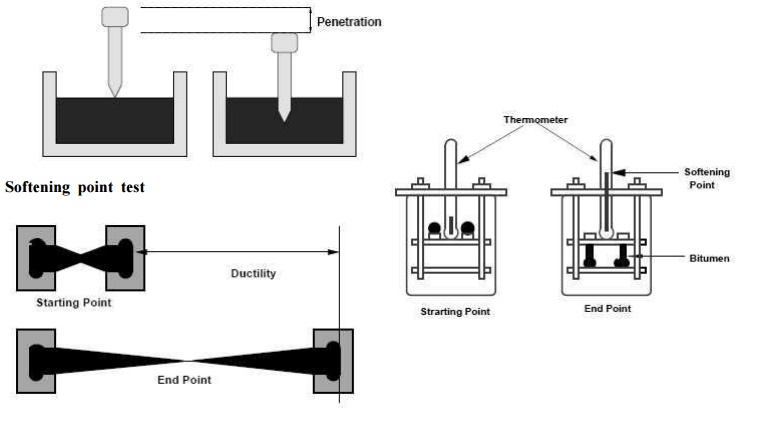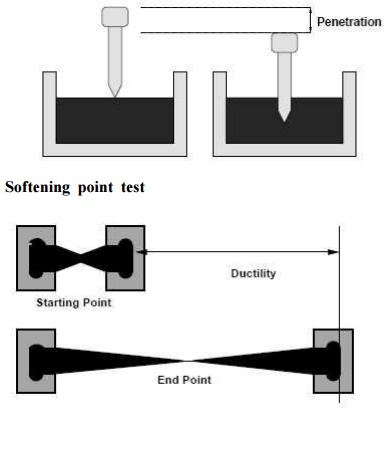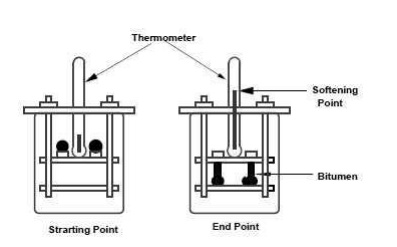Chapter: Civil : Highway Planning and Alignment : Highway Construction Materials And Practice
Tests on bitumen

Tests on bitumen
There are a number of tests to assess the
properties of bituminous materials. The following tests are usually conducted
to evaluate different properties of bituminous materials.
1. Penetration
test
2. Ductility
test
3. Softening
point test
4. Specific gravity test
5. Viscosity
test
6. Flash and
Fire point test
7. Float
test
8. Water
content test
9. Loss
on heating test
1.Penetration test
It measures the hardness or softness of bitumen by
measuring the depth in tenths of a millimeter to which a standard loaded needle
will penetrate vertically in 5 seconds. BIS had standardised the equipment and
test procedure. The penetrometer consists of a needle assembly with a total
weight of 100g and a device for releasing and locking in any position. The
bitumen is softened to a pouring consistency, stirred thoroughly and poured
into containers at a depth at least 15 mm in excess of the expected
penetration. The test should be conducted at a specified temperature of 25o
C. It may be noted that penetration value is largely influenced by any
inaccuracy with regards to pouring temperature, size of the needle, weight
placed on the needle and the test temperature. A grade of 40/50 bitumen means
the penetration value is in the range 40 to 50 at standard test conditions.

In hot
climates, a lower penetration grade is preferred. The Figure shows a schematic
Penetration Test setup.
Ductility is the property of bitumen that permits it to
undergo great deformation or elongation. Ductility is defined as the distance
in cm, to which a standard sample or briquette of the material will be
elongated without breaking. Dimension of the briquette thus formed is exactly 1
cm square. The bitumen sample is heated and poured in the mould assembly placed
on a plate. These samples with moulds are cooled in the air and then in water
bath at 27o C temperature. The excess bitumen is cut and the surface
is leveled using a hot knife. Then the mould with assembly containing sample is
kept in water bath of the ductility machine for about 90 minutes. The sides of
the moulds are removed, the clips are hooked on the machine and the machine is
operated. The distance up to the point of breaking of thread is the ductility
value which is reported in cm. The ductility value gets affected by factors
such as pouring temperature, test temperature, rate of pulling etc. A minimum
ductility value of 75 cm has been specified by the BIS. Figure 23.4.2 shows
ductility moulds to be filled with bitumen.
Softening point denotes the temperature at which the bitumen
attains a particular degree of softening under the specifications of test. The
test is conducted by using Ring and Ball apparatus. A brass ring containing
test sample of bitumen is suspended in liquid like water or glycerin at a given
temperature. A steel ball is placed upon the bitumen sample
and the liquid medium is heated at a rate of 5o C
per minute. Temperature is noted when the softened bitumen touches the metal
plate which is at a specified distance below. Generally, higher
softening
point indicates lower temperature susceptibility and is preferred in hot
climates. Figure shows Softening Point test setup.

2
Specific gravity test and Viscosity test
Specific
gravity test
In paving jobs, to classify a binder, density property is of
great use. In most cases bitumen is weighed, but when used with aggregates, the
bitumen is converted to volume using density values. The density of bitumen is
greatly influenced by its chemical composition. Increase in aromatic type
mineral impurities cause an increase in specific gravity.
The
specific gravity of bitumen is defined as the ratio of mass of given volume of
bitumen of known content to the mass of equal volume of water
at 27o C. The specific gravity can be measured using either
pycnometer or preparing a cube specimen of bitumen in semi solid or solid
state. The specific gravity of bitumen varies from 0.97 to 1.02.
Viscosity
test
Viscosity
denotes the fluid property of bituminous material and it is a measure of
resistance to flow. At the application temperature, this characteristic greatly
influences the strength of resulting paving mixes. Low or high viscosity during
compaction or mixing has been observed to result in lower stability values. At
high viscosity, it resist the compactive effort and thereby resulting mix is
heterogeneous, hence low stability values. And at low viscosity instead of
providing a uniform lm over aggregates, it will lubricate the aggregate
particles. Orifice type viscometers are used to indirectly find the viscosity
of liquid binders like cutbacks and emulsions. The viscosity expressed in
seconds is the time taken by the 50 ml bitumen material to pass through the
orifice of a cup, under standard test conditions and specified temperature.
Viscosity of a cutback can be measured with either 4.0 mm orifice at 25o
C or 10 mm orifice at 25 or 40o C.
Related Topics